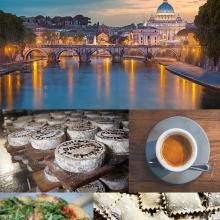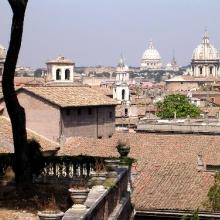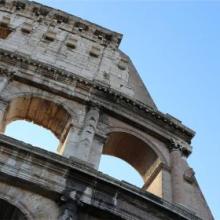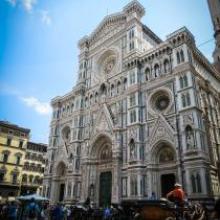Description
Dialogues Across Time in Italy: The English Spring Italy Program offers three courses (15 credits) that take full advantage of Italy's unique character as an artistic and historical land, with multiple layers of meaning that include preceding ages in an intertextual dialogue across time. The course on “Gift and Sacrifice” explores in a foundational way the primordial origins of all societies through relations of reciprocal exchange, obligation, and religious piety. The second course, "Eloquent Bodies" will examine representations of the body in art history. The third course, "Italy in the European Imagination" will explore the role Italy plays in the literary works of authors from other European countries. The program will also offer students an opportunity to become acquainted with the monuments and cultural heritage of four other cities in Italy: Verona, Padova, Venice, and Florence.
ENGL 498 or CLIT 496 (5 credits) is a course titled "Gift and Sacrifice" and explores in a foundational way the primordial origins of all societies through relations of reciprocal exchange, obligation, and religious piety.
ENGL 395 or CLIT 395 (5 credits) is a course called "Italy in the European Imagination" and explores the relationship between various European writers and the country of Italy. Since at least the Renaissance, Italy has fascinated writers in numerous ways, from the setting for a number of Shakespeare's plays to the symbolic role it plays in more modern works, like those of Thomas Mann and Joseph Conrad. We will explore the role Italy plays in the works of authors from several other European countries, including plays by Shakespeare, poems by Percy Bysshe Shelley and Robert Browning, and fiction by Joseph Conrad and Thomas Mann.
ENGL 295 is a course titled "Eloquent Bodies" and will illuminate visual traditions across Renaissance, Mannerist, and Baroque art collections in Rome.
Courses
ENGL 498 or C LIT 496 (5 credits): Gift and Sacrifice
Mona Modiano, UW faculty
This seminar will introduce students to concepts of gift and sacrifice, two foundational structures of exchange that have ruled economic, social, and religious life since the inception of culture. Both raise fundamental questions about the constitution of communities by means of the binding power of gratitude, or, more ominously, sacrificial scapegoats. As a contemporary critic wrote (Mark Osteen), the study of the gift touches on some of the most fundamental concerns that define our humanity: “freedom and autonomy, calculation and spontaneity, gratitude and generosity, risk and power.” The study of sacrifice in turn generates a series of provocative as well as unsettling questions: whether conceptions of the sacred are inextricably linked with violence, whether sacrificial rituals escalate rather than contain violence, whether recuperative economies that seek gain out of loss inevitably fuel sacrificial behavior, whether capital punishment is not in effect a contemporary version of ancient sacrificial rites, and whether communities can ever escape the predicament of uniting against a designated scapegoat and resorting to sacrificial ideologies.
These and related questions will form the subject of this course, which will introduce students to foundational texts in anthropology, psychoanalysis, and sociology (Marcel Mauss, The Gift; Sigmund Freud, Totem and Taboo; Rene Girard, Violence and the Sacred) and to the representation of gift and sacrifice in the Bible, folklore, film (The Merchant of Venice; Babette’s Feast; Breaking the Waves) and literature (Aeschylus, Agamemnon, William Shakespeare, The Merchant of Venice and Julius Caesar, Shirley Jackson's The Lottery, selected poems by Samuel Taylor Coleridge, William Wordsworth, and Lord Byron). The course will also deal with specifically Roman customs of gift and sacrifice and use the rich resources in Padova, Venice, Florence, and Rome to document the various representations, especially in Medieval and Renaissance Italian art, of three founding biblical stories of sacrifice: the sacrifice/murder of Abel by Cain, the sacrifice of Isaac by Abraham, and the sacrifice of Christ.
ENGL 498 meets the Senior Capstone requirement for Language and Literature majors in the English Department.
Learning Goals
The goal of the course is to make students aware of the complexity and importance of understanding the function, both positive and negative, of activities and societal norms based on gift and sacrifice. I tell the students that while all think that they know the meaning of gift and sacrifice, by the end of the course they will in fact not be able to define these terms so easily, if at all. They will become aware of the extraordinary variety of cultural practices of gift and sacrifice that cannot be encompassed in easy definitions. The course will also make them reflect on their own experience of when a gift misfires, for example, and why. It will shed light on the unappealing but nonetheless prevalent practice of constituting communities by means of an exclusion, the sacrificial victim. The assessment of students will take place through class discussion, oral group reports on assigned texts, written term papers, and exams.
ENGL 395 or C LIT 395 (5 credits): Italy in the European Imagination
Norman Arkans, UW faculty
This course will explore the relationship between various European writers and the country of Italy. Since at least the Renaissance, Italy has fascinated writers in numerous ways, from the setting for a number of Shakespeare's plays to the symbolic role it plays in more modern works, like those of Thomas Mann and Joseph Conrad. We will explore the role Italy plays in the works of authors from several other European countries, including plays by Shakespeare, poems by Percy Bysshe Shelley and Robert Browning, and fiction by Joseph Conrad and Thomas Mann.
Learning Goals
The goals of the course are to introduce students to a variety of literary voices that have been shaped by their imaginative engagement with Italy, including writers from different times and countries working in the three major genres: drama, poetry and fiction. Some of the questions we will attempt to answer include why and how Italian culture influences the art and what advantages it brings to the artistic objectives of the authors. Are the themes universal or specific to Italy? Can we imagine these works set elsewhere and what difference, if any, would it make? Ultimately, the goal is to develop students' critical reading and analytical abilities across the three genres. Work in the course will be evaluated from participation in class discussions and written assignments.
ENGL 295 (5 credits): Eloquent Bodies
Ricardo De Mambro Santos, Rome faculty
This course will focus on the analysis of the different forms of representation of human figures and their various narratives from Renaissance to Baroque. The class will explore the aesthetic implications as well as the ideological, religious, and cultural agendas related to the emergence of new visual compositions in which the organization of images – and, more specifically, the arrangement of human
figures within art-related spaces – could be compared to a discursive, rhetorical practice known as “ut pictura poësis,” according to a theoretical paradigm that establishes a profound connection between images and words and asserts the idea that a painting, a sculpture, and even an architecture should be “read” as a particular visual text. From the analysis of fifteenth-century art theories published in Rome,
Florence, and Milan, to the investigation of Leonardo’s, Michelangelo’s as well as Raphael’s depictions of the human body, the course will provide a close examination of some exemplary artworks produced in Italy between 1400 and 1600. Special attention will be dedicated also to the interpretation of images made in contrast with Renaissance canons by masters such as Caravaggio and Bernini. Furthermore, the course aims to examine, from a different perspective, the multiple ways in which patrons and collectors may have played a relevant role in the production of artworks in accordance with Renaissance, Mannerist, and Baroque stances. Accordingly, many of our meetings will take place
outside the classroom, in galleries, museums, and art collections in order to give our students the opportunity to undertake a direct, personal experience of original artworks often displayed in their original locations.
Learning Goals
In this art history course, students will acquire an introductory background and critical tools to understand the production, reception and diffusion of art works in Italy from the Renaissance to Neoclassicism. Through formal analysis and close investigation, students will develop a historically based interpretation of artworks within their specific historical context. Rome, Florence and Milan will become our classroom as we explore the paintings, sculptures, churches and palaces commissioned by Italy's noble families. Specifically, we will investigate the motivation behind lavish spending: Why were certain expenditures made, and how were those who made them seen by the intended audience?
In this course, students will be graded in accordance with the following assignments and criteria: 1. Active class participation and critical engagement (50%) 2. Written research-based paper (at least 10 double-spaced pages) analyzing the historical significance of one work of art examined during the course (50%).
ENGL 295 counts as VLPA credit and does not count toward the English major (it's an Art History course).
Cost
Estimated program fee: $8,250
Included in the program fee
- $450 Study Abroad Fee
- Instruction
- Housing
- Program activities and program travel
Not included in the program fee
- Airfare - average price subject to when and where you buy your ticket - $1,500
- Food
- UW Student Abroad Insurance ($62/month)
- Other health expenses/immunizations
- Personal spending money
Payment Schedule
Program fees will be posted to your MyUW student account and can be paid the same way that you pay tuition and other fees. Check your MyUW Account periodically for due dates.
| Payment Type | Payment Amount | Payment Due Date |
| TOTAL FEES CHARGED | $8,250 | April 13, 2018 |
Dates & Deadlines
Important Dates
- Information Session: To be announced.
- Application Deadline: Tuesday, November 15, 2017
- Required Seattle Pre-Departure Orientations: TBA in Winter Quarter
- Arrival in Rome: TDB 2018
- First Day of the quarter: Monday, March 26th, 2018
- Last Day of the Program: Friday, June 1st, 2018
- Departure from Apartments: Saturday, June 2nd, 2018
Pre-Departure Orientations
Participants will be required to attend a total of three hours of pre-departure orientations in Seattle during Winter Quarter. Two pre-departure sessions will be 1.5 hours each.
In addition to the orientations given by the UW English Department, program participants must also attend an in-person pre-departure orientation facilitated by the Study Abroad office.You must register for this orientation through your online study abroad account in order to attend scheduled orientations. You can visit the Orientation section of the Study Abroad website to view the current orientation schedule. The general Study Abroad orientation must be completed prior to March 1, 2018.
Any problems or financial losses that occur as as a result of not attending the orientations are entirely the responsibility of individual students.
The Spring in Rome program begins with two days of required on-site orientation sessions in Rome scheduled for all day __________(Dates to be determined), 2018.
Passports and Visas
You will need a passport to travel to Italy. It can take time for your application to be processed and your passport issued, so it's a good idea to apply for (or renew) your passport as early as possible. According to the U.S. government's passport services website, the total cost is $135 for a 10-year passport, and the University Neighborhood Service Center, 4534 University Way NE, is the passport acceptance facility closest to campus. The most extensive passport information, including application procedures, fees, office locations, and even printable application forms you can download, is available from the State Department's passport services website. Some general information on applying for passports is also available by calling the National Passport Information Center toll-free number: 1-877-487-2778, while an automated appointment line and some general information is available at the Seattle Passport Agency: (206) 808-5700.
If you are not a U.S. Citizen, a visa, or additional documentation, may be required for your period of study in Rome. If a visa is required, international students participating on the program are encouraged to obtain their student visitor visas and/or any other required documentation no later than January 31, 2018. It can take several weeks to process your application and to issue your visa. Participants should begin the application process as early as possible (but no earlier than 90 days before your arrival date in Rome).
We will assist students with this process in any way we can, but please remember that we are not immigration experts. Obtaining a visa (should you need one) is your responsibility.
Travel
Travel Arrangements
Participants make their own travel arrangements - there is no group flight to Rome. Airfares fluctuate too often and too much to make any estimates here, but we encourage students to begin shopping for flights as soon as they are officially enrolled in the program. Council/STA Travel is a student-friendly travel agency we recommend, but students often find great deals on their own by taking advantage of frequent flyer miles and individual airline promotions.
NOTE to participants: Please be wary of some of the cheap airfare websites. Read all the fine print. Tickets may not be changeable, and flights may not always fly as scheduled. Students have run into problems with these sites in the past. Just use your best judgment and consider your options carefully.
IMPORTANT: As noted above, the program begins with a required on-site orientation session at the UWRC (Rome Center) scheduled for the day of or day after arrival (and after settling into apartments). Students must plan their travel so they arrive in Rome no later than March 26 so they will be ready to attend the (required) on-site orientation. Students will be expected to depart on the morning of Saturday, June 2.
Weather/What to Pack
There are two kinds of travelers: those who pack light and those who wish they did. We recommend that students pack a week's worth of clothing, with options for layering. Comfortable shoes are a must and a light waterproof shell is a good idea, as well as a warm sweater or fleece for cooler evenings. Students should keep in mind that they will have limited storage space in their place of residence. For more packing and backpacking ideas, check out the Rick Steve's website on packing for Spring in Italy, as well as other websites that discuss climate in Rome during Spring.
Amy Feldman-Bawarshi
Academic Adviser
afeldman@uw.edu




